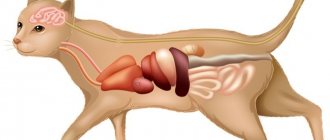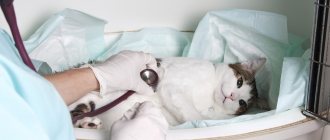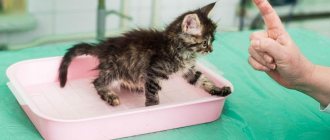One of the most common reasons for visiting the clinic is cystitis (urocystitis) in cats. Animals of all ages suffer from it; the symptoms and treatment of cystitis in a kitten will differ little from those in adult animals. What to do if a cat has cystitis?
First, let's look at the types of this disease.
Types of cystitis
According to the type of pathology, feline cystitis is divided into:
Acute cystitis
Symptoms of acute cystitis in a cat are characterized by pronounced manifestations: anxiety, blood in the urine, etc. Treatment should be started immediately.
Chronic cystitis
Characterized by a long course of the disease. Typically, pathological processes in the bladder persist without visible symptoms. If the pet is stressed or has a cold in the bladder, the disease will manifest itself again. Thus, chronic cystitis in a cat can periodically worsen.
According to the type of inflammatory process, urocystitis can be divided into:
Hemorrhagic cystitis
Hemorrhagic cystitis is characterized by the fact that the cat has blood in its urine.
Serous-catarrhal cystitis
There is mucus in the urine.
Purulent cystitis
The urine test shows pus. The cat may have white discharge from the urethra.
Feline idiopathic cystitis (FCI)
The trigger is stress, defects in the inner lining of the bladder. The urine test does not contain bacteria or sand.
Risk factors
In felines, urinary tract inflammation is most often caused by stress disorders, bladder stones, and in more rare cases, bacteria.
The disease develops in cats of any age. However, we can distinguish a category of animals in which the risk of getting sick is increased:
- obese;
- sedentary;
- eating unbalanced and irregularly.
Cystitis most often affects males (whether they are castrated or not) due to the structure of the urethra. The urethra in cats is narrow, has bends (in the shape of the letter S) and narrowing. Sand or mucus plugs clog the urethra, preventing the flow of urine. In cats, complete blockage of the canal is extremely rare.
Causes of cystitis
There are several factors that cause cystitis. How to treat cystitis in a cat depends on them and the severity of the symptoms.
Bacteria
Bacterial inflammation of the bladder occurs when pathogenic microflora begins to develop on its wall. Most often it gets there retrogradely, that is, from the urethra. Sometimes natural microflora, which is opportunistic (normally does not cause disease), begins to grow due to favorable conditions for it: too concentrated urine, hypothermia, stress, etc. The number and type of bacteria, their resistance, compliance The doctor’s recommendations determine how long it will take to treat bacterial cystitis in cats.
Insufficient fluid intake
Cats, before domestication, lived in desert areas. Their bodies are adapted to conserve water. They rarely feel thirsty, and their kidneys concentrate their urine. A high concentration of urine leads to the fact that salts in the urine begin to precipitate, sand and stones (uroliths) are formed, which irritate the bladder wall and provoke the development of inflammation.
Sedentary lifestyle
In nature, cats constantly hunt. Domesticated Barsiks, although they have not lost their hunting instinct, move much less in apartment conditions. With high activity, the suspension in the bladder is shaken, does not settle on the walls and is excreted naturally. When the cat sleeps for 10-16 hours, and the food in the bowl does not try to escape from it, the suspension settles on the walls and provokes the development of the disease.
Unbalanced diet
The diet must be balanced so that the kidneys do not have to excrete excess trace elements in the urine. The development of cystitis is influenced by products that lead to changes in urine pH or contain large amounts of crystal-forming substances. Improper nutrition disrupts the natural environment of the bladder and provokes the development of inflammation.
Urolithiasis (UCD)
This is a pathology in which uroliths are formed in the urinary system (US). They have different sizes, shapes and structures. Some types of stones can be dissolved with proper treatment. Some do not dissolve in principle and can only be removed surgically.
Disturbance of urine outflow
In this regard, males are more susceptible to MWS diseases. In cats, in the area of the penis there is a significant narrowing of the urethra (C-shaped bend), so it can become clogged and cause stagnation of urine at the slightest inflammation or the presence of a significant amount of sediment in the urine. Prostate diseases also complicate the flow of urine. Therefore, treatment of cystitis in a castrated cat is easier than in a stud cat with prostate diseases. Does cystitis with urinary stagnation occur in cats? Of course. But due to the wide urethra, urinary retention in females is much less common.
Stress
Many owners notice signs of cystitis in their pets after experiencing stress. Do cats get cystitis because they are overexcited? Yes. The mechanism of development of FCI is not fully understood, but the most common factor is stress. The causes of stress are very different: moving, having a new pet, a trip to the clinic, a new litter box, guests in the house, etc. All cats are different, some like to meet guests or ride in cars, others hide under the bathtub from the noise of fireworks. Therefore, this factor in the development of cystitis depends solely on the pet’s temperament.
Defects of the inner lining of the bladder (UB)
The inner wall of the bladder may have structural defects, areas of loss of integrity, neoplasms, etc. Since urine is a rather aggressive environment, it can irritate the wall of the bladder and provoke the development of cystitis.
Other causes of cystitis
Cystitis as a secondary pathology can be caused by diseases such as:
- Kidney diseases (nephritis, acute and chronic kidney disease, etc.);
- Neoplasms (tumors of the bladder or neighboring organs);
- Injuries (fall, car injury, blow, bite);
- Diabetes;
- Feline viral immunodeficiency;
- Poisoning.
In these cases, it is necessary to treat the underlying disease, since cystitis in a cat becomes a concomitant disease.
What it is?
Many people know that cystitis is an inflammation of the bladder. Accordingly, urocystitis is a “combined” inflammatory process that involves damage not only to the bladder, but also to the urethra, that is, the urinary duct through which urine is released into the external environment during the act of urination. To be fair, let’s say that in nature “pure” cystitis is generally quite rare, since the reason for which the bladder turned out to be inflamed will almost certainly have a negative effect on the urethra.
What are the main reasons for the development of pathology? Many infectious diseases and pathological conditions, including poisoning with heavy metal salts, can cause combined inflammation of the bladder and urethra. The most common cause of cystitis in cats is some kind of bacterial pathology , in which pathogenic microflora begins to develop directly in the bladder. Other common causes include: bladder stones, tumors or polyps in the bladder, as well as pathologies of the anatomical structure of the genitourinary system (especially in females). Some animals are diagnosed with interstitial or “sterile urocystitis.” In this case, inflammation develops without external influence on the body. Veterinarians suggest that some kind of autoimmune process is to blame in this case. Let's look at some of these predisposing factors in more detail.
Symptoms of cystitis in a cat
How does cystitis manifest in cats?
- Frequent urination (pollakiuria);
- Pain when urinating (stranguria);
- Blood in the urine (hematuria);
- Urinating in places not intended for this purpose (periuria);
- Changes in gait and natural postures. Obvious signs: the gait becomes slower; while walking, the cat puts its hind legs a little wider, arches its lower back a little, and tucks its pelvis;
- Excessive interest in licking the belly and perineum;
- Pain in the abdomen - can be noticed when you pick up your pet or try to touch the belly;
- Unsuccessful attempts to urinate - the cat sits on the tray for a long time, strains, screams, but cannot squeeze out a single drop. This is a very alarming symptom indicating a blockage of the urethra. This condition is life-threatening for the pet and requires an immediate visit to the doctor;
- Vomiting, refusal to eat, lethargy - these signs may be the result of severe cystitis or blockage of the urethra. Such symptoms require immediate medical attention.
Subscribe to the newsletter and receive a discount at the pet store “Lubimchik”
Thank you for subscribing!
Symptoms of cystitis in cats can be combined with each other, and treatment will be different in each case. Some signs of cystitis may go away on their own, but reappear over time.
Diagnosis of cystitis
Diagnosis of cystitis requires at least three studies:
- Examination by a specialist. The doctor will collect a detailed medical history and conduct an examination: assess the condition of the mucous membranes, the size of the bladder, the degree of pain, the presence of swelling or pathological discharge in the perineum;
- General urine analysis. pH level, density, presence of blood, leukocytes, salts and their type. It is important that protein levels cannot be assessed in a urine test if blood is present. After the course of treatment, the test will need to be taken again to monitor the dynamics, then the assessment of protein levels becomes informative. Cystocentesis (a puncture through the abdominal wall) is the most informative method of collecting a urine sample. This procedure is carried out under ultrasound guidance. Before the test, the pet must not urinate for 2-4 hours to ensure the MP is full. This is a routine procedure that does not require anesthesia, and cats usually respond even more calmly to it than to injections. You can also collect urine yourself. Wash the tray thoroughly with a chemical-free brush and scald with boiling water. When your pet urinates, collect the urine in a urine container and take it to the laboratory. There are special tubes with a preservative, in which urine is stored longer. Check with your doctor to see if these tubes are available. An important point: the presence of bacteria in such an analysis does not indicate the presence of bacteria in the bladder. They can enter the tube from the tray itself, from the paws, fur, or from the urethra. Therefore, we strongly recommend a urine test by cystocentesis;
- Ultrasound will help identify signs of inflammatory processes and their severity, and assess the presence of suspension/sand. In most cases, ultrasound can diagnose the presence of uroliths (stones) or neoplasms. Before the study, it is important that the pet does not urinate for 2-4 hours.
None of these research methods will be sufficiently informative without the other. Only after carrying out all of the above tests will the doctor be able to tell what to give the cat for cystitis.
If the results of basic tests are controversial or if the disease progresses for a long time without positive dynamics, other studies may be prescribed:
- Bacterial culture of urine with determination of sensitivity to antibiotics . It is necessary if, despite treatment, the cat’s cystitis does not go away for a long time, and bacteria are present in the urine. Some bacteria have developed resistance (addiction) to antibiotics. In this case, a urine test is taken by cystocentesis (it is important to take urine directly from the bladder). The sample is sent to the laboratory, where these bacteria are grown on nutrient media and their type and sensitivity to various drugs are determined.
- Urethroscopy/cystoscopy. Endoscopic examination method, performed under sedation. Using a special tube with a camera at the end, the urethra and bladder are examined. This is a very informative method, since you can visually assess what the mucous membrane looks like. If necessary, during cystoscopy, an analysis can be taken from the bladder wall for bacterial culture or cytology of bladder tissue;
- X-ray of the abdominal cavity , including with radiopaque agents. Allows you to identify uroliths in the kidneys and bladder, areas of narrowing or dilatation of the urethra, ureters, pelvis, and violation of the integrity of the bladder wall.
Urocystitis in cats: symptoms, treatment
Urocystitis
Urocystitis is a chronic or acute, purulent, phlegmonous or diphtheric, catarrhal inflammation of the bladder involving the urethra.
Most often, the cause of urocystitis is lymphogenous, hematogenous penetration of microflora into the bladder, including from other organs. Possible ascending development of inflammation (through the urethra) or descending (from the renal pelvis). The disease may be caused by catheterization of the bladder.
Common causes of urocystitis are urolithiasis and nephrolithiasis, trauma, urinary retention (tumors, urinary stones, scar contraction, sphincter spasms), irritating substances penetrating the kidneys, ammonia fermentation of urine.
Passive hyperemia of the bladder and hypothermia predispose to urocystitis.
When there is inflammation in the bladder, staphylococci, streptococci, and Pseudomonas aeruginosa are found. Urocystitis is often focal. Inflammatory products appear in the urine - microorganisms, bladder epithelium, blood cells, pus. Due to irritation of the bladder, the amount of urine decreases and urination becomes frequent. Your cat may have a fever.
Urocystitis. Symptoms.
In acute urocystitis the following is noted: ♦ Animal depression or anxiety. ♦ Frequent painful urination. ♦ Anorexia (a syndrome consisting of a complete lack of appetite). ♦ Increase in temperature.
On palpation, enlargement, pain and hardening of the bladder are noted. Daily diuresis is maintained (if the kidneys are not affected), but the amount of urine excreted with each urination is reduced (pollakiuria).
During ammonia fermentation, freshly excreted urine gives off the smell of ammonia; it contains tripel phosphate crystals, microorganisms, bladder and blood epithelial cells, and protein. With proper treatment, acute urocystitis does not last long; if it is delayed, it becomes chronic.
Urocystitis. Treatment.
Milk is included in the cat's diet and irritating and spicy foods are excluded. If the urine reaction is acidic, hexamethylenetetramine (urotropine) is given, and if the urine is alkaline, salol is given. Also, for alkaline urine reactions, decoctions of bearberry leaves are indicated. To suppress infection, sulfonamides (sulfapyrimidine, sulfacyl, urosulfan, streptocide) are used. Antibiotics (penicillin, terramycin, syntomycin, streptomycin), furadonin (see “Pyelonephritis”).
If Pseudomonas aeruginosa is present in the urine, acridine preparations (acrigonine, trypaflavin, gonacrine) are very effective. purulent urocystitis, wash the bladder through a catheter with a 0.5% solution of alum, tannin, collargol, 0.1% solution of silver nitrate, 2-3% solution of boric acid.
Health to you and your pets.
Source: Handbook of Treatment for Dogs and Cats. Sidorov I.V.
Treatment of cystitis in cats
The question of how to treat cystitis in a cat cannot be answered unequivocally. There is no magic pill.
How long it takes for cystitis to go away in cats depends on the duration of the disease, the cause of the development of cystitis, and the individual characteristics of the pet.
Inflammation of the bladder should be treated comprehensively. Drugs for the treatment of cystitis in cats are aimed at eliminating symptoms
- one, to fight the cause - two, to prevent relapses - three.
You should not self-medicate; let your doctor decide which tablets to give your cat for cystitis. Many human medications are not only dosed differently, but they are also lethal to animals.
For cystitis, your doctor may prescribe the following:
- Antispasmodic drugs;
- Painkillers (NSAIDs), provided there are no contraindications;
- Antibiotics. A long course of at least 10 days, with monitoring of urine analysis until the antibiotic is discontinued. This way you can adjust the duration of use;
- Preparations containing glycosaminoglycans (GAGs). Designed to restore the inner wall of the bladder. When prescribed by a doctor, they are safe, but there is still little evidence of the effectiveness of their use;
- Diets with acidifying/alkalinizing additives to correct urine pH levels;
- Increased water consumption;
- Specialized diets for a long time;
- Preparations with pheromones for cats to reduce stress;
- Antidepressants. Strictly as prescribed by a doctor, they are used in cases where the pet continues to experience stress, despite improved living conditions, treatment and the use of pheromones.
We remind you: how and with what to treat cystitis in a cat, the doctor will decide after conducting an examination and receiving research results.
The drugs come in different forms: drops, tablets, injections, and food supplements for cystitis for cats. Ask your doctor to find the most convenient way for you to administer the medication, as the main thing is to maintain trust and love between you and your pet.
The timeliness of treatment and compliance with the doctor’s recommendations directly affect how long it takes to treat cystitis. On average, treatment can take from a couple of weeks to several months. For example, treatment of urolithiasis may take several months, but bacterial cystitis can be treated without complications in a couple of weeks.
Sometimes drops are used for cystitis in cats
Therapeutic measures
Already at the first manifestations of bladder inflammation in a cat, the owner must take action. In an advanced state, healing is a long process.
Treatment of cystitis in cats depends on the form and type of the disease. The main thing is to eliminate the cause, and not limit yourself to treating symptoms.
Treatment uses a combination of various drugs, which is determined by the doctor.
Bacterial cystitis in cats is a treatable disease, but due to its serious consequences it is the most dangerous.
A urinary tract infection can be treated at home. But this does not mean that the cat owner should choose the medicine. The main goal is to destroy the causative agent of cystitis. Antibiotics are prescribed for this. These could be pills or injections.
The doctor can make the first appointment without waiting for test results. Then adjust the treatment.
Only for the idiopathic type of cystitis, therapy consists of eliminating symptoms (incontinence and sudden urges to urinate). Features of therapy and care for ICC:
- Analgesics are prescribed to reduce pain.
- The animal can mark in any place. It is necessary to wash them thoroughly so that the cat does not subsequently adopt bad behavior and refuse the tray.
- The cat's litter box is cleaned much more often.
- Change your diet.
- Drink heavily with water.
- Eliminate possible stress factors.
If an attack of cystitis does not go away, antidepressants may be prescribed to change the pet’s mood.
If inflammation is a consequence of uroliths, it is ICD that is treated. The main goal is to remove stones.
Struvite can be dissolved with a therapeutic diet. If after two weeks the examination shows no result, then the stones are oxalate. This type of stone cannot be dissolved by diet or medication. Oxalates are removed surgically.
In case of acute urinary retention (a day or more) due to a stone blocking the urethra, catheterization is performed.
After urine flow has been restored, the bladder is flushed with an antiseptic through the catheter (5-7 days) to flush out as much sediment as possible. Then medications are prescribed to relieve inflammation. Droppers are made with Ringer's solution to eliminate intoxication.
If it is impossible to rinse the urethra through a catheter (for example, the stone is too large), an operation is performed to widen the urethra - urethrostomy.
The choice of any drug for cats for cystitis and the duration of the course are determined strictly by a veterinarian. Therapy is prescribed only after the results of laboratory tests; in each case it is individual.
Antibiotics (tablets and injections)
Among the antibiotics for cystitis for bacterial infections, the following are used:
- Enroxil
- Baytril
- Ceftriaxone
- Cefotaxime
- Kobaktan
- Tsefkin
- Ampioks
- Ceftriaxone
- Sinulox
Treatment with antibacterial drugs lasts 2-3 weeks. Then, a week after the course, a urine culture is performed to ensure that the drug was chosen correctly. For complicated infections, treatment lasts 3-4 weeks.
Measures to prevent cystitis in cats
We discussed how to cure cystitis, but how to prevent relapses?
Prevention of cystitis in cats is very important and consists of four simple rules:
- Adequate water intake. It is important to ensure that the cat drinks approximately 40-50 ml/kg/day. Place bowls of water in places where your pet likes to spend time. You can use vessels of different shapes and materials: plastic, glass and metal; glasses, bowls and plates, even buckets, the main thing is that the cat drinks more. Try adding a drop or two of milk or broth to the water and change it regularly. You can increase your fluid intake with wet diets;
- Balanced diet. We will talk about it in detail in the next section;
- Physical activity . Normally, cats need to move a lot. Find a way to excite your Murzik: teasing toys, laser pointers, bows, paper balls, etc.;
- Reduced stress levels. Is your pet afraid of guests, hiding from noise, and a visit to the clinic is accompanied by terrible screams? The following recommendations will help you:
The pet should have a separate tray in a fairly secluded place. There should be several scratching posts in the apartment. It is better to place them not where it is convenient for you, but where it is convenient for your pet: next to bowls, on window sills, on the corners of furniture or walls that he likes to rub against. Special houses and complexes can help. Cats feel more comfortable when they spend a lot of time upstairs. If there are high places in the apartment that you do not use, put a bed there and let it be the cat’s observation point. Regular games and rewards will also help. And, of course, sedatives with pheromones. They create a cat-friendly atmosphere in the home and promote calmer behavior.
Causes of cystitis
The disease occurs for the following reasons:
- Exposure to cold.
- Development of an infectious process in the genitourinary organs.
- Chronic diseases.
- Disruption of metabolic processes in the animal’s body due to overfeeding or, conversely, starvation.
- Stress.
- Damage to the back and abdomen.
- Damage to the walls of the bladder as a result of improperly performed procedures.
- Using a non-sterile catheter.
- Diabetes disease.
- Drinking small volumes of liquid, due to which urine becomes concentrated, and this contributes to the development of infectious processes.
What to feed a cat with cystitis during treatment?
Regardless of the type of cystitis, it is important to provide your pet with an abundant supply of moisture to the body. When the pH level of urine changes, the addition of acidifying/alkalinizing additives is required. And, of course, you need to take into account such a complication of cystitis as urolithiasis, so you need to monitor the level of crystal-forming substances in the diet (P, Ca, Mg, etc.) and feed accordingly.
If your cat eats commercial diets, during illness you should give preference to wet food. Therapeutic diets include acidifying additives to change urine pH and contain a minimum of crystal-forming components, as well as thirst-stimulating substances.
If you are following homemade diets, you will also need to provide plenty of moisture. You can salt your food, but without passion. Cats need salt, but it should not be in excess. In small quantities it will be useful, as it stimulates thirst. It is better to exclude foods high in P, Ca, Mg: meat, fish, cottage cheese. Limit the level of protein in the diet to a physiological minimum.
Veterinary nutritionists will help you create a suitable diet in the Petstory mobile application. You can download it from the link.
Nutrition and care
During treatment, it is important to create comfortable living conditions for the cat. Avoid stress and hypothermia.
In case of a bacterial infection, there is no need to additionally warm the bedding or apply heat to the cat’s belly. This can cause an increase in bacteria.
For urolithiasis in cats, medicated food must be prescribed depending on the type of stone. It is recommended to drink plenty of fluids to flush out the urine.
A number of brands have a line of Urinari food for the treatment and prevention of urological disorders:
- Hills Prescription Diet C/D Urinary Stress is suitable for cats with idiopathic cystitis.
- Reduces the risk of relapse of lower urinary tract diseases Hills Prescription Diet Metabolic+Urinary Feline. Indicated for dissolving struvite stones. This food is also suitable for overweight cats.
- Royal Canin Urinary S/O is suitable for dissolving struvite and as food for the prevention of the idiopathic form of the disease.
Other brands also have veterinary diets: Happy Cat, Farmina, Brit, Primordial, Monge.
Calcium stones do not dissolve, but there are also foods that prevent their occurrence:
- Hills Diet Feline K/D;
- Purina Pro Plan Veterinary Diets UR St/Ox;
- Eukanuba Urinary Oxalate.











